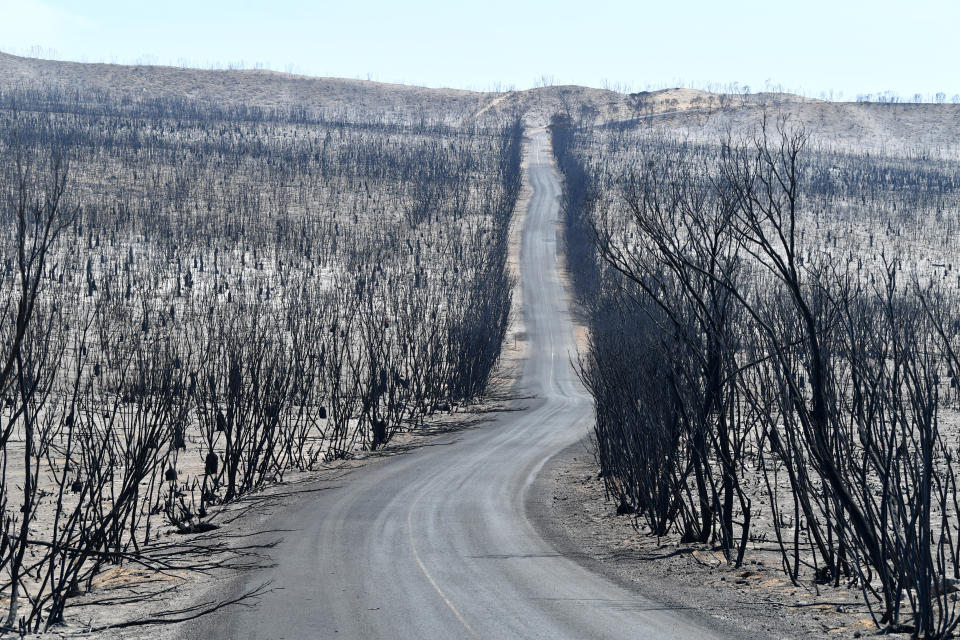NASA images show bushfire smoke circling the world before returning to Australia
Smoke from Australia’s raging bushfires is circulating the globe and is expected to do a full circle before returning to its origin.
According to NASA’s website, the unprecedented conditions have led to a large number of fire-induced thunderstorms forming, triggered by the uplift of ash, smoke and burning material.
The space station says once it is in the stratosphere, smoke too can travel thousands of miles from where it originates, with it starting to do a circuit of the globe.
Already affecting New Zealand – with skies in Auckland in the North Island turning an orange hue as a result of the bushfires – smoke has travelled halfway around Earth and even crossed South America since January 8.
“The smoke is expected to make at least one full circuit around the globe, returning once again to the skies over Australia,” NASA said.
The Naval Research Laboratory’s Mike Fromm said this was the most extreme case of fire-induced storms to break out in Australia, with the only other significant event occurring during Black Saturday fires in 2009.
“Over the past week, NASA satellites have observed an extraordinary amount of smoke injected into the atmosphere from the Australian fires and its subsequent eastward dispersal,” NASA said.
“... satellite shows smoke plumes reaching 17.7km vertically into the lower stratosphere from some energetic firestorms.”
Melbourne shrouded by thick blanket of smoke
Melburnians woke on Tuesday morning to hazardous air pollution levels as smoke from bushfires in Victoria’s east and NSW drifts across the state.
The CBD recorded hazardous levels of fine particles in the air from 12am to 4am and has since been categorised as very poor by the Environmental Protection Authority.
Air quality forecasts for Geelong, Latrobe Valley, Melbourne, central region, all of Gippsland and the north central region are all listed as hazardous for Tuesday by the EPA.

Firefighters have spent the night being called out to fire alarms triggered by the smoke haze.
The Metropolitan Fire Brigade told radio station 3AW on a normal night crews would attend about 20 false alarms, but overnight they were called out to about 200, with each needing to be treated as a potential fire.
The fires burning through Victoria's east and northeast have claimed the lives of four men, 353 homes and 548 other structures.
Sixteen fires are still burning and 1.4 million hectares have been destroyed across the state.
Slightly calmer weather forecast is allowing firefighters to try to build containment lines, while military personnel are working to make isolated towns accessible by road.
Rain to ease fire conditions
The Bureau of Meteorology shared its weekly rain forecast map on Monday morning, prompting celebrations from NSW’s Rural Fire Service on Twitter.
“If this BOM rainfall forecast comes to fruition then this will be all of our Christmas, birthday, engagement, anniversary, wedding and graduation presents rolled into one,” the RFS said.
The map shows some parts of NSW’s central and northern tablelands receiving about 50mm for the week, and about 25mm falling all the way from the Victorian border to Queensland.

Fire-ravaged East Gippsland and parts of Victoria’s east will also receive up to 25mm.
And the majority of drought-stricken Queensland can expect 15 to 25mm of rain by Friday.
Firies brace for Kangaroo Island flare-ups
Flare-ups across the Kangaroo Island bushfire are expected to continue for up to two weeks, as fire crews battle to bring it fully under control.
The blaze has already burnt through 210,000 hectares inside a 588-kilometre perimeter, destroying 65 homes and hundreds more buildings.
The Country Fire Service says it is still burning in various spots along the 120-kilometre eastern flank.
Almost 400 firefighters are still deployed on the island with 83 fire trucks supported by 130 farm fire units.
Five water-bombing aircraft are also being used with four observation aircraft helping target their efforts.
CFS chief officer Mark Jones said crew rotations were continuing to ensure the wellbeing of personnel.

"We're trying to rotate crews as much as possible, but to their credit, people keep putting their hand up and volunteering to go," he said.
"At this time I'm not concerned. We've got lots of resources on the island.
"But, of course, I'm sensitive to the demands that have been placed against these volunteers."
Cooler conditions across the fire zone in the coming days are expected to give the CFS a better chance to deal with the areas of most concern including Stokes Bay, Cygnet River, Vivonne Bay, Seal Bay, Seddon and Birchmore.
With AAP
Do you have a story tip? Email: newsroomau@yahoonews.com.
You can also follow us on Facebook, Instagram and Twitter and download the Yahoo News app from the App Store or Google Play.




